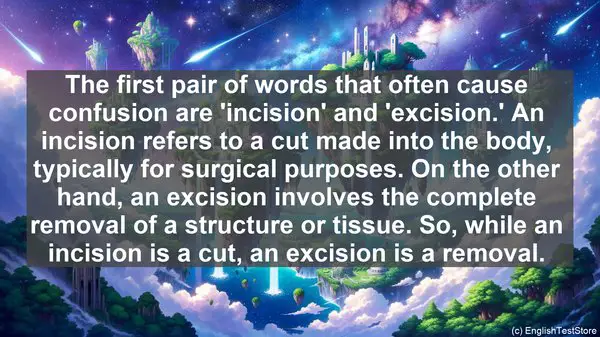Introduction
Welcome to today’s lesson. As veterinary students, it’s crucial to have a strong grasp of the terminology we use in surgery. However, there are some words that often trip us up. Today, we’ll be discussing the top 10 commonly confused words in veterinary surgery.
1. Incision vs. Excision
The first pair of words that often cause confusion are ‘incision’ and ‘excision.’ An incision refers to a cut made into the body, typically for surgical purposes. On the other hand, an excision involves the complete removal of a structure or tissue. So, while an incision is a cut, an excision is a removal.
2. Ligature vs. Suture
Next up, we have ‘ligature’ and ‘suture.’ Both terms are related to closing wounds, but they have different meanings. A ligature is a thread or material used to tie off a blood vessel, while a suture is a stitch used to close a wound. So, ligatures are used to control bleeding, while sutures are used for wound closure.
3. Anesthesia vs. Analgesia
Moving on, let’s clarify the difference between ‘anesthesia’ and ‘analgesia.’ Anesthesia refers to the state of unconsciousness or insensitivity to pain induced by drugs. On the other hand, analgesia refers specifically to the absence of pain. So, while anesthesia ensures the patient is unconscious, analgesia focuses on pain relief.
4. Asepsis vs. Sterility
Now, let’s talk about ‘asepsis’ and ‘sterility.’ While both terms relate to cleanliness and the prevention of infection, they have different applications. Asepsis refers to the absence of disease-causing microorganisms, while sterility refers to the complete absence of any living organisms. So, asepsis is essential in preventing infection, while sterility is crucial in procedures like surgeries.
5. Debridement vs. Excision
The next pair of words that often cause confusion are ‘debridement’ and ‘excision.’ Debridement involves the removal of dead or damaged tissue from a wound to promote healing. On the other hand, excision, as we discussed earlier, is the complete removal of a structure or tissue. So, debridement is more focused on cleaning and preparing a wound, while excision is about removal.
6. Laceration vs. Abrasion
Let’s now differentiate between ‘laceration’ and ‘abrasion.’ A laceration is a deep, irregular cut or tear in the skin or tissue, often caused by a sharp object. On the other hand, an abrasion is a superficial injury where the top layer of skin is scraped off. So, lacerations are deeper and more severe than abrasions.

7. Hemostasis vs. Hemorrhage
Moving on, we have ‘hemostasis’ and ‘hemorrhage.’ Hemostasis refers to the process of stopping bleeding, while hemorrhage is the excessive or uncontrolled bleeding. So, while hemostasis is about controlling bleeding, hemorrhage is the opposite, indicating uncontrolled blood loss.

8. Prophylaxis vs. Treatment
Next, let’s clarify the difference between ‘prophylaxis’ and ‘treatment.’ Prophylaxis refers to preventive measures taken to avoid a disease or condition, while treatment involves actions taken to cure or manage an existing disease. So, prophylaxis is about prevention, while treatment is about addressing an existing issue.
9. Evisceration vs. Herniation
Now, let’s discuss ‘evisceration’ and ‘herniation.’ Both terms relate to the displacement of organs, but they have different meanings. Evisceration refers to the complete or partial removal of organs from their normal position, while herniation is the protrusion of an organ through an abnormal opening. So, evisceration involves the removal, while herniation is about displacement.
10. Resection vs. Anastomosis
Lastly, let’s differentiate between ‘resection’ and ‘anastomosis.’ Resection involves the removal of a portion of an organ or tissue, while anastomosis is the surgical connection of two structures. So, resection is about removal, while anastomosis is about joining or reconnecting.
